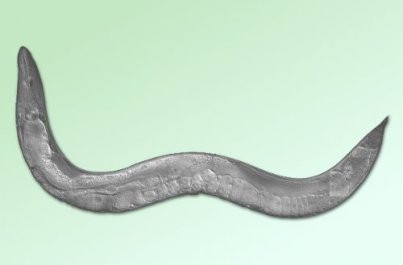“What are you eating? It smells delicious” you hear someone say from across the room as your coworker walks in with a presumably tasty meal. You breathe in as the odor wafts by you and immediately feel sick to your stomach. That nauseating smell belongs to the same meal you bought last week that made you sick. You try to stay but the smell is so repugnant that you end up leaving. If this has ever happened to you, you have experienced aversive learning in action. Learning is critical to our ability to navigate the world. We can learn because our brains ou r plastic, meaning that our brains can change as a result of experience. How is learning mediated by changes to our underlying neural circuits? This is the type of question that neuroscientist Dr. Yun Zhang has been studying at the Center for Brain Science at Harvard University. In order to identify the neural mechanisms of learning Dr. Zhang focuses on studying the roundworm, C. elegans. A major advantage of studying these organisms is that neuroscientist have been able to map the connectivity of all 302 neurons of the C. elegans nervous system. Coupled with a variety of molecular, cellular and genetic tools, C. elegans has allowed neuroscientists to identify molecules, neurons and circuits involved in learning.
r plastic, meaning that our brains can change as a result of experience. How is learning mediated by changes to our underlying neural circuits? This is the type of question that neuroscientist Dr. Yun Zhang has been studying at the Center for Brain Science at Harvard University. In order to identify the neural mechanisms of learning Dr. Zhang focuses on studying the roundworm, C. elegans. A major advantage of studying these organisms is that neuroscientist have been able to map the connectivity of all 302 neurons of the C. elegans nervous system. Coupled with a variety of molecular, cellular and genetic tools, C. elegans has allowed neuroscientists to identify molecules, neurons and circuits involved in learning.
In order to study learning Dr. Zhang’s lab has focused on olfactory learning which plays an important role in identifying and locating food sources. Because locating food is essential to the survival of all animal species it is likely that the basic mechanisms of olfactory learning are highly conserved. Dr. Zhang first showed that through olfactory learning C. elegans can learn to avoid pathogenic bacteria (Zhang et al. 2005). C. elegans eat bacteria and in the lab these organisms are typically grown on a plate containing a harmless strain of Escherichia coli OP50 bacteria. However, there are some types of bacteria such as the P. aeruginosa PA14 that are pathogenic and cause infection. C. elegans have different preferences for the bacterial odors of these two strains depending on their experience. C. elegans raised on a plate only contain OP50 bacteria showed no difference in preference for OP50 or PA14 bacterial odors. However, if C. elegans were raised on a plate containing OP50 and PA14 showed increased aversion towards PA14. The same was true for C. elegans that were raised a plate contain only OP50 but exposed to PA14 bacteria for four hours before testing. These worms avoided the PA14 bacterial odors much like you would avoid food that made you sick.
What neural circuit mechanisms allow these C. elegans to learn to avoid pathogenic bacterial odors? One clue came from studying the behavior of mutant C. elegans. The study found that tph-1 mutants, which results in a serotonin deficiency, were unable to learn to avoid pathogenic bacteria. Because C. elegans have a small number of neurons the researchers were able to identify the neurons that were not functioning properly in the mutants. They showed that expressing tph-1 in the ADF neuron in tph-1 mutants rescued aversive olfactory learning. They then showed that the MOD-1 seratonin-gated chloride channel was necessary for olfactory learning. These data suggest that serotonin plays a central role in olfactory aversive learning.
Further work in Dr. Zhang’s lab has continued to dissect the neural circuit mechanisms involved in aversive olfactory learning. They showed that two sensory neurons AWB and AWC are required for C. elegans to display their innate preference for PA14 bacteria. ADF neurons and its corresponding modulatory circuit is necessary for aversive olfactory learning to occur (Ha et al. 2010). Ha et al. were able to map out a circuit corresponding to naïve and learned preferences. Recently, Dr. Zhang’s lab identified a variety of molecular components involved in aversive olfactory learning circuits including Gα-proteins, guanylate cyclases, and cGMP-gated channels. Additionally, they showed that neuropeptides mediate food-odor preferences (Harris et al. 2014). While there is still much more to discover, these experiments have begun to demystify how experience-dependent learning occurs at a molecular level.
To find out more please join Dr. Yun Zhang in the CNCB Marilyn Farquhar Seminar Room at 4 PM on April 19th or check out some of her awesome publications on the topic here.
References
Ha, H. I., Hendricks, M., Shen, Y., Gabel, C. V., Fang-Yen, C., Qin, Y., … & Zhang, Y. (2010). Functional organization of a neural network for aversive olfactory learning in Caenorhabditis elegans. Neuron, 68(6), 1173-1186.
Harris, G., Shen, Y., Ha, H., Donato, A., Wallis, S., Zhang, X., & Zhang, Y. (2014). Dissecting the signaling mechanisms underlying recognition and preference of food odors. The Journal of Neuroscience, 34(28), 9389-9403.
Zhang, Y., Lu, H., & Bargmann, C. I. (2005). Pathogenic bacteria induce aversive olfactory learning in Caenorhabditis elegans. Nature, 438(7065), 179-184.
Andre DeSouza is a first year student in the UCSD Neuroscience Program. He is currently rotating in Dr. Martyn Gouldings lab where he is working on a project investigating the mechanisms of pain and itch in the spinal cord.